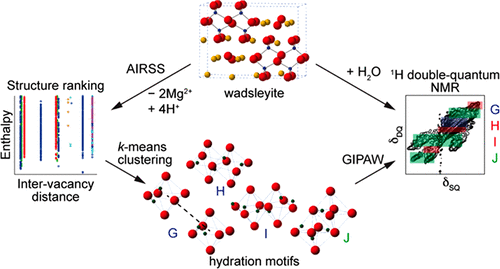当前位置:
X-MOL 学术
›
J. Am. Chem. Soc.
›
论文详情
Our official English website, www.x-mol.net, welcomes your feedback! (Note: you will need to create a separate account there.)
A Picture of Disorder in Hydrous Wadsleyite – Under the Combined Microscope of Solid-State NMR Spectroscopy and Ab Initio Random Structure Searching
Journal of the American Chemical Society ( IF 14.4 ) Pub Date : 2019-01-24 , DOI: 10.1021/jacs.8b11519 David McKay 1 , Robert F. Moran 1 , Daniel M. Dawson 1 , John M. Griffin 2 , Simone Sturniolo 3 , Chris J. Pickard 4, 5 , Andrew J. Berry 6 , Sharon E. Ashbrook 1
Journal of the American Chemical Society ( IF 14.4 ) Pub Date : 2019-01-24 , DOI: 10.1021/jacs.8b11519 David McKay 1 , Robert F. Moran 1 , Daniel M. Dawson 1 , John M. Griffin 2 , Simone Sturniolo 3 , Chris J. Pickard 4, 5 , Andrew J. Berry 6 , Sharon E. Ashbrook 1
Affiliation

|
The Earth’s transition zone, at depths of 410–660 km, while being composed of nominally anhydrous magnesium silicate minerals, may be subject to significant hydration. Little is known about the mechanism of hydration, despite the vital role this plays in the physical and chemical properties of the mantle, leading to a need for improved structural characterization. Here we present an ab initio random structure searching (AIRSS) investigation of semihydrous (1.65 wt % H2O) and fully hydrous (3.3 wt % H2O) wadsleyite. Following the AIRSS process, k-means clustering was used to select sets of structures with duplicates removed, which were then subjected to further geometry optimization with tighter constraints prior to NMR calculations. Semihydrous models identify a ground-state structure (Mg3 vacancies, O1–H hydroxyls) that aligns with a number of previous experimental observations. However, predicted NMR parameters fail to reproduce low-intensity signals observed in solid-state NMR spectra. In contrast, the fully hydrous models produced by AIRSS, which enable both isolated and clustered defects, are able to explain observed NMR signals via just four low-enthalpy structures: (i) a ground state, with isolated Mg3 vacancies and O1–H hydroxyls; (ii/iii) edge-sharing Mg3 vacancies with O1–H and O3–H species; and (iv) edge-sharing Mg1 and Mg3 vacancies with O1–H, O3–H, and O4–H hydroxyls. Thus, the combination of advanced structure searching approaches and solid-state NMR spectroscopy is able to provide new and detailed insight into the structure of this important mantle mineral.
中文翻译:

含水 Wadsleyite 中的无序图片——在固态核磁共振光谱和 Ab Initio 随机结构搜索的组合显微镜下
地球过渡带深度为 410-660 公里,虽然由名义上无水的硅酸镁矿物组成,但可能会发生明显的水合作用。尽管水合作用在地幔的物理和化学性质中起着至关重要的作用,但人们对水合作用的机制知之甚少,因此需要改进结构表征。在这里,我们提出了对半含水(1.65 wt% H2O)和完全含水(3.3 wt% H2O)wadsleyite的从头随机结构搜索(AIRSS)研究。在 AIRSS 过程之后,使用 k 均值聚类来选择去除重复项的结构集,然后在 NMR 计算之前对这些结构进行更严格的几何优化。半水模型确定基态结构(Mg3 空位,O1-H 羟基)与之前的许多实验观察结果一致。然而,预测的 NMR 参数无法重现在固态 NMR 光谱中观察到的低强度信号。相比之下,由 AIRSS 产生的全水合模型,既可以分离缺陷也可以聚集缺陷,能够仅通过四种低焓结构来解释观察到的 NMR 信号:(i)基态,具有孤立的 Mg3 空位和 O1-H 羟基; (ii/iii) 与 O1-H 和 O3-H 物种共享边缘的 Mg3 空位;(iv) 与 O1-H、O3-H 和 O4-H 羟基共享边缘的 Mg1 和 Mg3 空位。因此,先进的结构搜索方法和固态核磁共振波谱的结合能够为这一重要地幔矿物的结构提供新的和详细的见解。预测的 NMR 参数无法重现在固态 NMR 光谱中观察到的低强度信号。相比之下,由 AIRSS 产生的全水合模型,既可以分离缺陷也可以聚集缺陷,能够仅通过四种低焓结构来解释观察到的 NMR 信号:(i)基态,具有孤立的 Mg3 空位和 O1-H 羟基; (ii/iii) 与 O1-H 和 O3-H 物种共享边缘的 Mg3 空位;(iv) 与 O1-H、O3-H 和 O4-H 羟基共享边缘的 Mg1 和 Mg3 空位。因此,先进的结构搜索方法和固态核磁共振波谱的结合能够为这一重要地幔矿物的结构提供新的和详细的见解。预测的 NMR 参数无法重现在固态 NMR 光谱中观察到的低强度信号。相比之下,由 AIRSS 产生的全水合模型,既可以分离缺陷也可以聚集缺陷,能够仅通过四种低焓结构来解释观察到的 NMR 信号:(i)基态,具有孤立的 Mg3 空位和 O1-H 羟基; (ii/iii) 与 O1-H 和 O3-H 物种共享边缘的 Mg3 空位;(iv) 与 O1-H、O3-H 和 O4-H 羟基共享边缘的 Mg1 和 Mg3 空位。因此,先进的结构搜索方法和固态核磁共振波谱的结合能够为这一重要地幔矿物的结构提供新的和详细的见解。能够同时实现孤立和聚集缺陷,能够仅通过四种低焓结构来解释观察到的 NMR 信号:(i) 基态,具有孤立的 Mg3 空位和 O1-H 羟基;(ii/iii) 与 O1-H 和 O3-H 物种共享边缘的 Mg3 空位;(iv) 与 O1-H、O3-H 和 O4-H 羟基共享边缘的 Mg1 和 Mg3 空位。因此,先进的结构搜索方法和固态核磁共振波谱的结合能够为这一重要地幔矿物的结构提供新的和详细的见解。能够同时实现孤立和聚集缺陷,能够仅通过四种低焓结构来解释观察到的 NMR 信号:(i) 基态,具有孤立的 Mg3 空位和 O1-H 羟基;(ii/iii) 与 O1-H 和 O3-H 物种共享边缘的 Mg3 空位;(iv) 与 O1-H、O3-H 和 O4-H 羟基共享边缘的 Mg1 和 Mg3 空位。因此,先进的结构搜索方法和固态核磁共振波谱的结合能够为这一重要地幔矿物的结构提供新的和详细的见解。
更新日期:2019-01-24
中文翻译:

含水 Wadsleyite 中的无序图片——在固态核磁共振光谱和 Ab Initio 随机结构搜索的组合显微镜下
地球过渡带深度为 410-660 公里,虽然由名义上无水的硅酸镁矿物组成,但可能会发生明显的水合作用。尽管水合作用在地幔的物理和化学性质中起着至关重要的作用,但人们对水合作用的机制知之甚少,因此需要改进结构表征。在这里,我们提出了对半含水(1.65 wt% H2O)和完全含水(3.3 wt% H2O)wadsleyite的从头随机结构搜索(AIRSS)研究。在 AIRSS 过程之后,使用 k 均值聚类来选择去除重复项的结构集,然后在 NMR 计算之前对这些结构进行更严格的几何优化。半水模型确定基态结构(Mg3 空位,O1-H 羟基)与之前的许多实验观察结果一致。然而,预测的 NMR 参数无法重现在固态 NMR 光谱中观察到的低强度信号。相比之下,由 AIRSS 产生的全水合模型,既可以分离缺陷也可以聚集缺陷,能够仅通过四种低焓结构来解释观察到的 NMR 信号:(i)基态,具有孤立的 Mg3 空位和 O1-H 羟基; (ii/iii) 与 O1-H 和 O3-H 物种共享边缘的 Mg3 空位;(iv) 与 O1-H、O3-H 和 O4-H 羟基共享边缘的 Mg1 和 Mg3 空位。因此,先进的结构搜索方法和固态核磁共振波谱的结合能够为这一重要地幔矿物的结构提供新的和详细的见解。预测的 NMR 参数无法重现在固态 NMR 光谱中观察到的低强度信号。相比之下,由 AIRSS 产生的全水合模型,既可以分离缺陷也可以聚集缺陷,能够仅通过四种低焓结构来解释观察到的 NMR 信号:(i)基态,具有孤立的 Mg3 空位和 O1-H 羟基; (ii/iii) 与 O1-H 和 O3-H 物种共享边缘的 Mg3 空位;(iv) 与 O1-H、O3-H 和 O4-H 羟基共享边缘的 Mg1 和 Mg3 空位。因此,先进的结构搜索方法和固态核磁共振波谱的结合能够为这一重要地幔矿物的结构提供新的和详细的见解。预测的 NMR 参数无法重现在固态 NMR 光谱中观察到的低强度信号。相比之下,由 AIRSS 产生的全水合模型,既可以分离缺陷也可以聚集缺陷,能够仅通过四种低焓结构来解释观察到的 NMR 信号:(i)基态,具有孤立的 Mg3 空位和 O1-H 羟基; (ii/iii) 与 O1-H 和 O3-H 物种共享边缘的 Mg3 空位;(iv) 与 O1-H、O3-H 和 O4-H 羟基共享边缘的 Mg1 和 Mg3 空位。因此,先进的结构搜索方法和固态核磁共振波谱的结合能够为这一重要地幔矿物的结构提供新的和详细的见解。能够同时实现孤立和聚集缺陷,能够仅通过四种低焓结构来解释观察到的 NMR 信号:(i) 基态,具有孤立的 Mg3 空位和 O1-H 羟基;(ii/iii) 与 O1-H 和 O3-H 物种共享边缘的 Mg3 空位;(iv) 与 O1-H、O3-H 和 O4-H 羟基共享边缘的 Mg1 和 Mg3 空位。因此,先进的结构搜索方法和固态核磁共振波谱的结合能够为这一重要地幔矿物的结构提供新的和详细的见解。能够同时实现孤立和聚集缺陷,能够仅通过四种低焓结构来解释观察到的 NMR 信号:(i) 基态,具有孤立的 Mg3 空位和 O1-H 羟基;(ii/iii) 与 O1-H 和 O3-H 物种共享边缘的 Mg3 空位;(iv) 与 O1-H、O3-H 和 O4-H 羟基共享边缘的 Mg1 和 Mg3 空位。因此,先进的结构搜索方法和固态核磁共振波谱的结合能够为这一重要地幔矿物的结构提供新的和详细的见解。






































 京公网安备 11010802027423号
京公网安备 11010802027423号